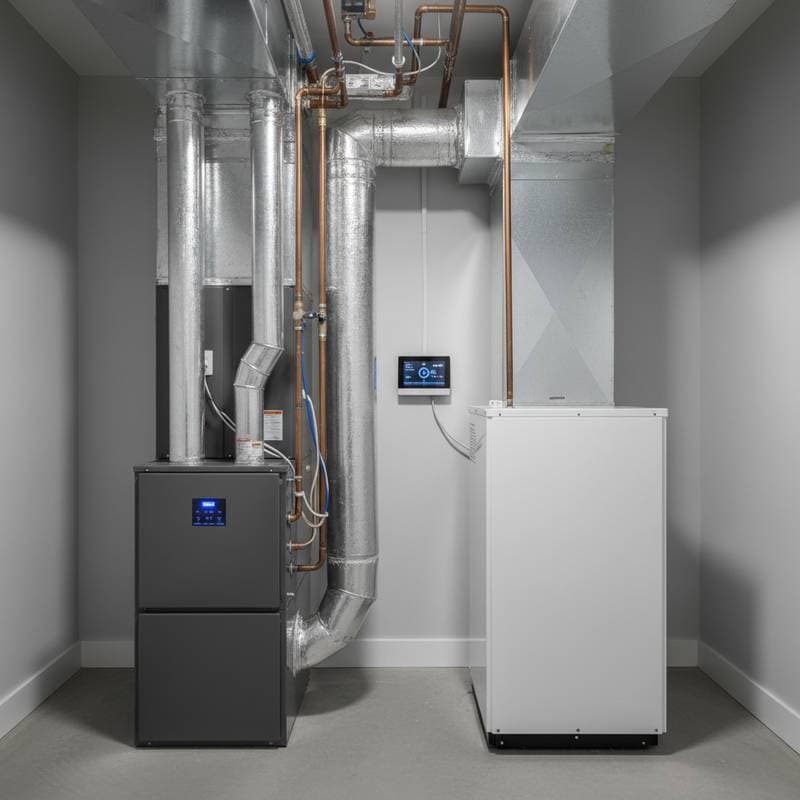Dual-Fuel HVAC: Integrating Gas and Electric for Optimal Efficiency
Homeowners often face challenges with HVAC performance during seasonal changes. One moment, the air conditioner operates steadily; the next, a sudden cold snap demands full furnace output. This inconsistency leads to higher energy consumption and elevated bills. In regions with variable weather, dual-fuel HVAC systems address these issues by intelligently selecting between gas and electric power for maximum efficiency.
Key Features of Dual-Fuel Systems
A dual-fuel system pairs a heat pump with a gas furnace to leverage the advantages of each. The heat pump manages heating and cooling in moderate temperatures by extracting ambient heat with high efficiency. In colder conditions, when the heat pump's performance declines, the system transitions to the gas furnace for powerful, dependable heating.
Professionals in the field note that this combination delivers balanced operation. The setup functions as an intelligent controller, evaluating energy sources to maintain comfort at minimal cost. Compared to a standalone gas furnace, this integration reduces heating expenses by up to 30 percent.
Addressing Typical HVAC Challenges
Traditional single-fuel systems struggle in climates with significant temperature variations. Heat pumps become less effective in extreme cold, and furnaces may overperform in milder weather, resulting in discomfort and excess energy use. Dual-fuel configurations resolve these problems by matching the appropriate technology to prevailing conditions.
Utility costs also fluctuate with seasonal demands, with gas prices peaking in winter and electricity rates rising in summer. Dual-fuel systems mitigate these variations by prioritizing the more cost-effective energy source, helping homeowners avoid peak pricing periods.
Operational Mechanics of Dual-Fuel Systems
The system relies on the heat pump as the main component for heating and cooling throughout much of the year. This unit moves heat rather than producing it, which conserves energy. When outdoor temperatures drop below a designated point, typically in the mid-30s Fahrenheit, the gas furnace activates automatically.
Homeowners experience seamless operation, with the switch occurring without noticeable interruption. A specialized thermostat oversees this process by tracking external temperatures and selecting the optimal mode. Experts advise selecting a smart thermostat that adapts to user habits and refines switching patterns for enhanced performance.
Strategies to Enhance System Efficiency
-
Conduct Routine Maintenance
Dual-fuel systems include both electrical and gas elements. Schedule inspections biannually to ensure synchronization and catch potential problems early, avoiding costly breakdowns. -
Maintain Clean Air Filters
Clogged filters impede airflow, straining the heat pump and furnace. Replace or clean them every one to three months, adjusting based on household dust levels and usage. -
Secure Ducts and Insulation
Leaks in ductwork can lose up to 20 percent of treated air. Inspect and seal all joints, then insulate exposed sections in attics or basements to preserve efficiency. -
Select an Advanced Thermostat
Opt for a model compatible with dual-fuel setups, featuring programmable or learning capabilities. This allows precise control over mode transitions and energy use. -
Monitor Refrigerant Levels
Adequate refrigerant ensures the heat pump operates at full capacity. Low levels diminish effectiveness and raise costs; have a technician check during service visits.
Benefits in Cost Savings and Comfort
These systems deliver measurable reductions in utility expenses while upholding high comfort levels. Savings become evident in the initial year, varying by local climate and rates, but typically lower both gas and electricity usage.
Indoor environments remain stable, free from temperature fluctuations. The heat pump offers gentle, uniform heating, supplemented by the furnace's robust output during harsh weather. One client described it as the home anticipating needs effortlessly.
Installation Factors to Consider
Planning a dual-fuel upgrade requires attention to several elements:
-
Initial Investment
Costs range from $5,000 to $12,000, influenced by unit capacity, manufacturer, and current setup. Energy savings and longer equipment life often recoup this within a few years. -
Utility Access
Reliable electricity and gas supply are essential. Properties lacking gas lines may require additional piping, though propane offers a viable substitute. -
Appropriate Sizing
Accurate sizing prevents inefficiency; oversized units short-cycle and wear quickly, while undersized ones fail to heat or cool adequately. Engage a certified technician for a detailed load assessment. -
Compliance Requirements
Adhere to local building codes, which often mandate permits for gas work. Qualified contractors manage these to guarantee safety and legality. -
Service Accessibility
Position components for easy maintenance access, given the system's multiple parts.
Environmental Impact
Dual-fuel technology supports reduced emissions by favoring the electric heat pump in suitable conditions, limiting reliance on fossil fuels. This approach promotes eco-friendly practices while preserving reliability.
HVAC specialist Laura Simmons observes, "Dual-fuel systems bridge efficiency and dependability. They provide comfort without trade-offs." Such integration appeals to those prioritizing sustainability alongside performance.
Steps to Implement a Dual-Fuel Solution
To determine suitability, consult a regional HVAC professional familiar with local weather trends. They evaluate bills, assess current systems, and propose tailored options balancing efficiency, comfort, and finances.
Compare multiple bids, focusing on efficiency metrics such as SEER for cooling and AFUE for heating; higher values indicate better performance. Inquire about utility rebates to offset installation expenses.
Dual-fuel systems enable reliable comfort and intelligent energy management. Professional installation ensures summer cooling and winter warmth operate flawlessly. Contact a trusted expert for a consultation to upgrade your home's HVAC performance.
Frequently Asked Questions
Q: How long does a dual-fuel HVAC system last?
A: With consistent maintenance, these systems endure 15 to 20 years. Routine servicing protects components like compressors and burners from early failure.
Q: Is a dual-fuel system worth it for mild climates?
A: Absolutely, as the heat pump manages most operations efficiently. The gas furnace serves as a reserve for infrequent cold periods, ensuring overall savings.



